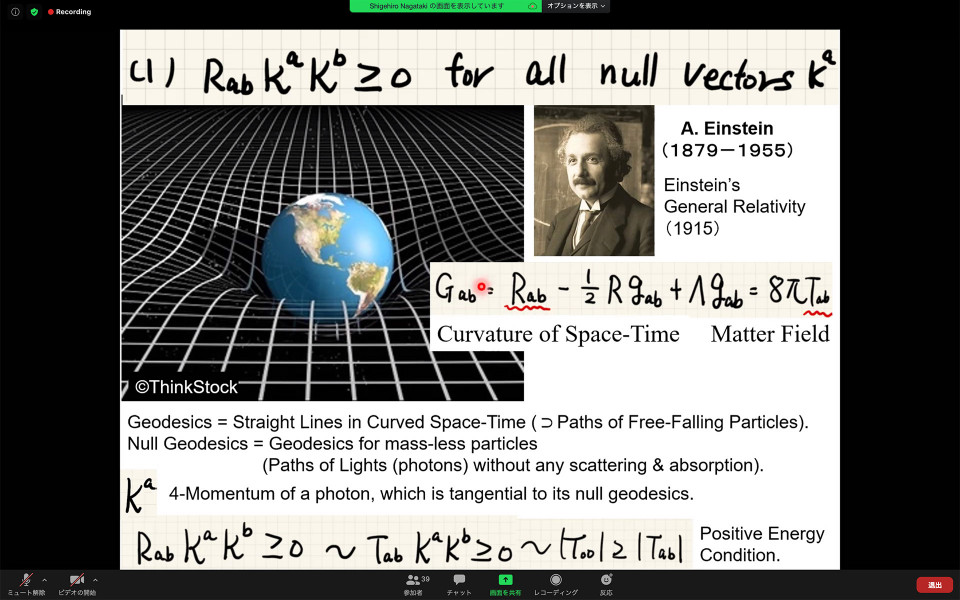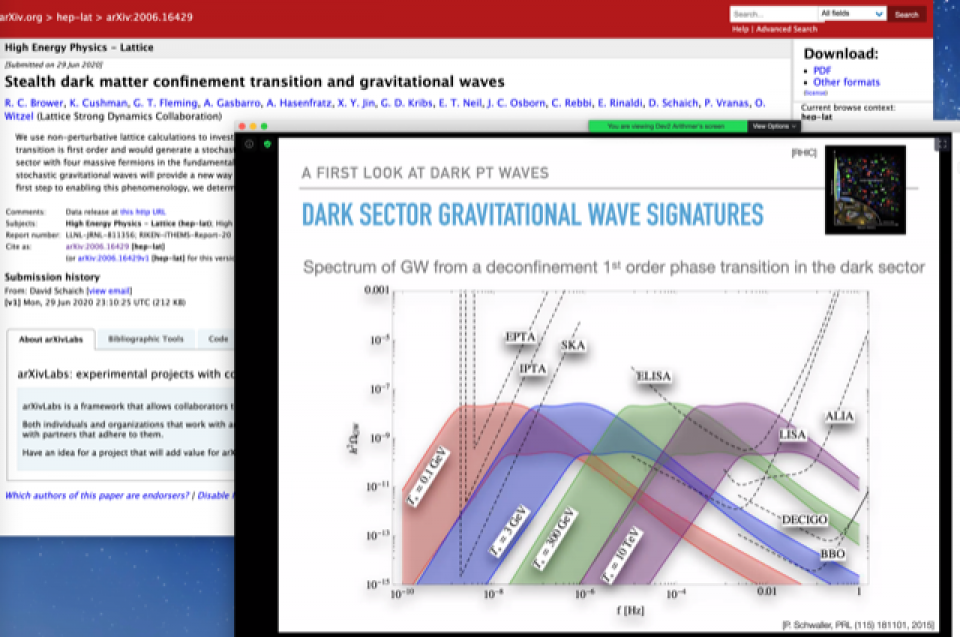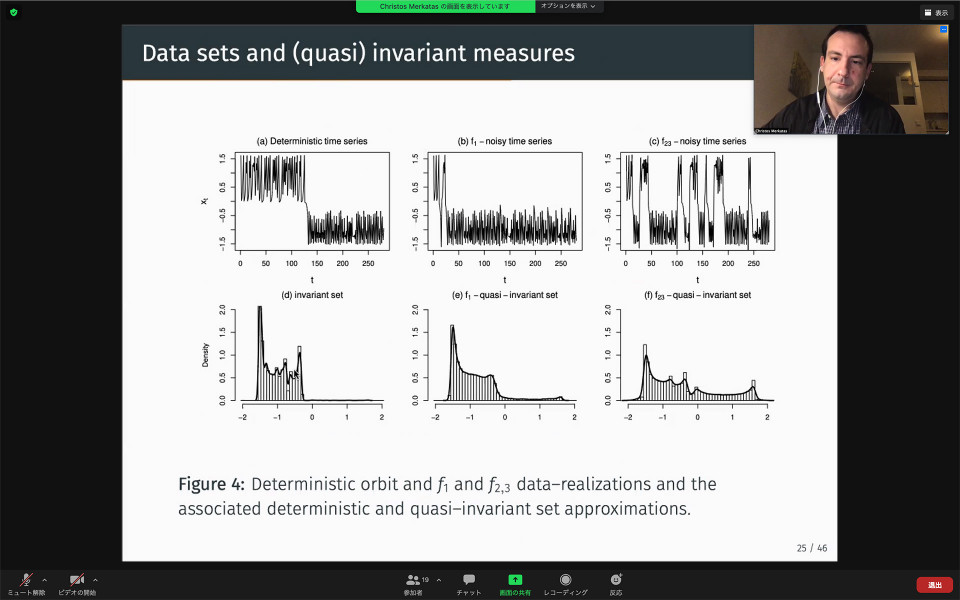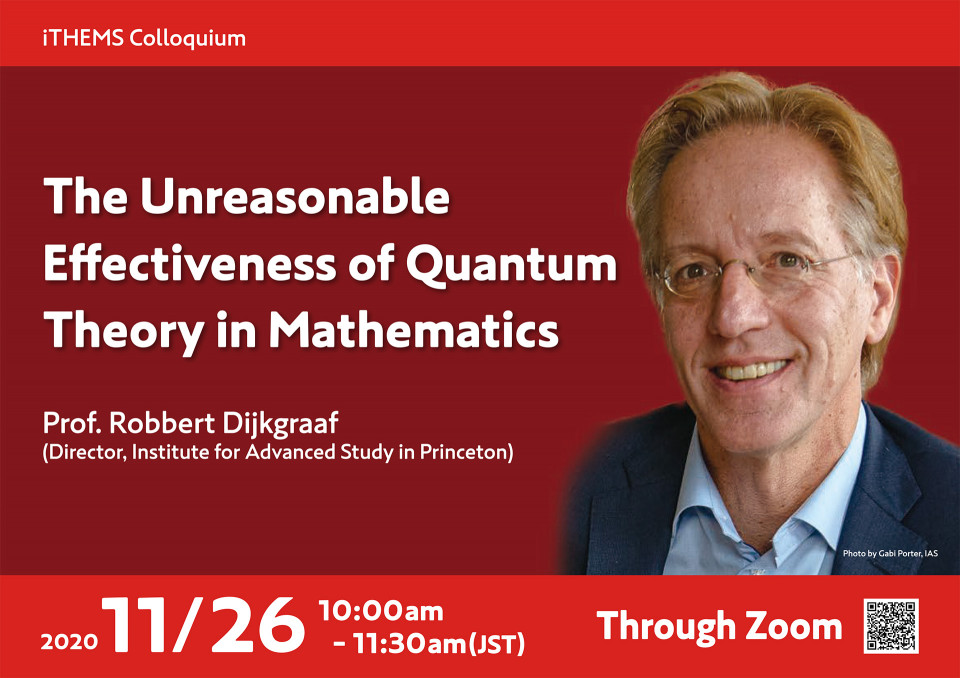Volume 124
Back to Newsletter List
Hot Topic
Coffee Meeting on October 9, 2020
2020-10-22
At the weekly coffee meeting on October 9th (Fri.), Dr. Jeremy Riousset (Florida Institute of Technology) gave a nice description on the properties of "Planetary lightning". After his talk, Dr. Shigehiro Nagataki (Deputy Program Director, iTHEMS) gave an explanation on this year's Nobel Prize in Physics "the discovery that black hole formation is a robust prediction of the general theory of relativity”.
Seminar Report
DMWG seminar by Dr. Rinaldi: Towards the cosmological signature of composite DM
2020-10-21
There are lots of dark matter (DM) candidates of particles and/or non-particles. One important requirement is that DM should be massive. When we consider the main origin of the visible mass in the Universe, it is the proton, i.e. a composite of three-quarks bound by the strong interaction. Then we can realize the DM mass naturally if we introduce similar dynamics in the dark sector. The interaction between the dark and the standard model sector is different from that of DM self-interaction, hence it is also safe under the cosmological requirements.
Among the varieties of composite DM models, the stealth DM scenario is a well-motivated one with minimal assumptions. It is different from other baryonic composite DM since it is developed for solving the problem of DM rather than for another mystery in the standard model. Let's consider the signatures in cosmological observations which we could expect for the stealth DM scenario.
Since the structure of the stealth DM is similar to that of the standard model baryons, they should experience the confined-unconfined phase transition in the early Universe. If the phase transition is of the 1st order, numerous vacuum babbles are produced in the transition from the false- to the true vacuum. The collision of these bubbles sources the low-frequency gravitational waves (GWs) of a ~nHz-mHz range.
However, it is difficult to calculate the physics around the phase transition. Indeed, it is not obvious whether the phase transition occurs in the 1st order or not. When it is of the 1st order, the gravitational wave spectrum is determined using the temperature of the Universe at the phase transition. Dr. Rinaldi and the members of the Lattice Strong Dynamics collaboration have investigated the phase transition in the stealth DM scenario by applying the sophisticated calculation techniques developed for the strongly-interacting sector in the standard model. They reveal that the lower bound of the 1st order phase transition temperature for the scenario, which is then directly converted to the lower bound on the frequency of the GW.
The technique should enable us to study DM from multiple aspects as is shown in this talk. Furthermore, this is the beginning of a new interdisciplinary study in which DM becomes the portal to connect the strong dynamics and GW cosmology, which could further enhance our understanding of this world!
Composite Dark matter and gravitational waves
October 20 (Tue) 10:00 - 11:00, 2020
Seminar Report
Biology Seminar by Dr. Christos Merkatas on October 21, 2020
2020-10-22
On October 21st, Dr. Christos Merkatas from Aalto University in Finland gave a talk at the iTHEMS Biology Seminar. His talk was entitled, “Bayesian Nonparametric Estimation of Random Dynamical Systems”. Suppose that the observed time series is small, and the noise process is non-Gaussian. How can we reconstruct and predict the behavior of the system? Dr. Merkatas showed that the proposed Bayesian approach enables us to reconstruct and predict the system by inferring the number of unknown components and their variances. According to him, the method can be applied to the problems in physics, biology, and economy. Since some of the audiences including me were not familiar with his method, we asked many basic questions. The talk by Dr. Merkatas was great and also educative. Gen Kurosawa
Bayesian nonparametric estimation of Random Dynamical Systems
October 21 (Wed) 14:00 - 15:00, 2020
Upcoming Events
Seminar
iTHEMS Theoretical Physics Seminar
Toward simulating Superstring/M-theory on a Quantum Computer
October 23 (Fri) 17:00 - 18:00, 2020
Masanori Hanada (Department of Mathematics, University of Surrey, UK)
We present a framework for simulating superstring/M-theory on a quantum computer, based on holographic duality. Because holographicduality maps superstring/M-theory to quantum field theories (QFTs), we can study superstring/M-theory if we can put such QFTs on a quantum computer --- but it still looks like a complicated problem, if we use a usual lattice regularization. Here we propose an alternative approach, which turns out to be rather simple: we map the QFT problems to matrix models, especially the supersymmetric matrix models such as the Berenstein-Maldacena-Nastase (BMN) matrix model. Supersymmetric matrix models have natural applications to superstring/M-theory and gravitational physics, in an appropriate limit of parameters. Furthermore, for certain states in the Berenstein-Maldacena-Nastase (BMN) matrix model, several supersymmetric quantum field theories dual to superstring/M-theory can be realized on a quantum device. It is straightforward to put the matrix models on a quantum computer, because they are just quantum mechanics of matrices, and the construction of QFTs is mapped to the preparation of certain states. We show the procedures are conceptually rather simple and efficient quantum algorithms can be applied. In addition, as a (kind of) byproduct, we provide a new formulation of pure Yang-Mills on quantum computer.
If you would like to participate, please register using the form below.
Venue: via Zoom
Event Official Language: English
External Event
The Mathematical Society of Japan: Cross-discipline and cross-industry research exchange meeting 2020
October 31 (Sat) 10:00 - 17:00, 2020
For more information, please refer to the related links. (in Japanese)
Venue: via Online
Event Official Language: Japanese
Seminar
iTHEMS Math Seminar
Mathematical aspects of quasi-Monte Carlo integration
November 5 (Thu) 16:00 - 18:10, 2020
Kosuke Suzuki (Assistant Professor, Graduate School of Advanced Science and Engineering, Hiroshima University)
In this talk, I will introduce mathematical aspects of quasi-Monte Carlo (QMC) integration. We aim to approximate the integral of a function on the d-dimensional hypercube [0,1]^d. A useful approach is Monte-Carlo (MC) integration, which uses randomly chosen samples. A drawback of MC is the rate of convergence; the standard deviation of the estimator converges as 1/sqrt(n) asymptotically in n. To have a better rate of convergence as O(log^d N/N) or more, QMC uses deterministic, uniformly distributed points.
In the first part, I will give an overview of QMC, such as star-discrepancy, Koksma-Hlawka inequality, and some explicit constructions as lattices and digital nets.
In the second part, I will show that QMC using lattices and digital nets can achieve a higher rate of convergence for smooth integrands.
Venue: via Zoom
Event Official Language: English
Colloquium
iTHEMS ColloquiumSupported by RIKEN SUURI CORPORATION
The Unreasonable Effectiveness of Quantum Theory in Mathematics
November 26 (Thu) 10:00 - 11:30, 2020
Robbert Dijkgraaf (Director, Institute for Advanced Study in Princeton, USA)
November 26 at 10:00-11:30, 2020 (JST)
November 25 at 20:00-21:30, 2020 (EST)
The physical concepts of quantum theory, in particular of quantum gravity and string theory, have proven to be extremely powerful in addressing deep problems in pure mathematics, from knot invariants to algebraic geometry. Is there such a thing as “quantum mathematics”? Should we add Feynman diagrams, strings, branes and black holes to the language of mathematics?
Venue: via Zoom
Event Official Language: English
If you would like to cancel your subscription or change your email address,
please let us know via our contact form.
Copyright © iTHEMS, RIKEN. All rights reserved.






